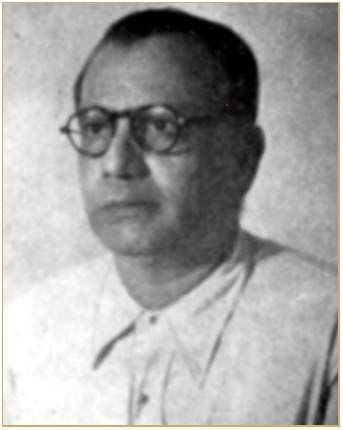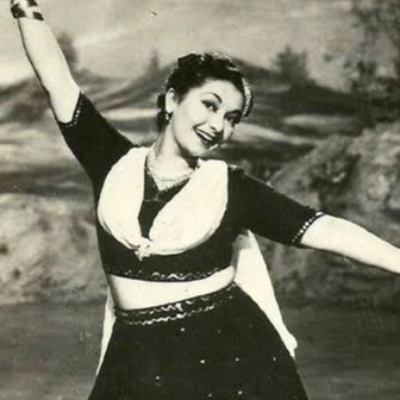Naresh Mitra

Subscribe to read full article
This section is for paid subscribers only. Our subscription is only $37/- for one full year.
You get unlimited access to all paid section and features on the website with this subscription.
Not ready for a full subscription?
You can access this article for $2 , and have it saved to your account for one year.
- Born: 18 May 1888 (Agartala, Tripura, British India)
- Died: 25 September 1968 (Calcutta, West Bengal, India)
- Primary Cinema: Bengali
Prominent and prolific Bengali actor, director and screenwriter Naresh Mitra (also known as Naresh Chandra Mitra) is known for films spanning several decades beginning from the silent era, such as Andhare Alo (1922), Maan Bhajan (1923), Naukadubi (1932), Gora (1938), and Kankal (1950). To him goes credit for directing the first film (silent) adaptation of Sharat Chandra Chattopadhyay’s popular novel Devdas in 1928. He is also known for directing films starring Bengali cinema’s popular star Uttam Kumar such as Bou Thakuranir Haat (1953) and Annapurnar Mandir (1954). He was also associated with the Bengali folk Jatra. He also penned the screenplay of the films Kankal and Bindur Chheley (1952).
Born on 18 May 1888 in Agartala, Tripura, he was a law graduate from Calcutta University. Drawn to the stage, he became a major star. Starting in 1922 at Minerva Theatre with Chandragupta, he joined Star Theatre with Karnarjun in 1923. Acting in several plays for different companies, he mostly essayed the villain’s role.
He entered films to complete Andhare Alo (1922), acting and directing the film which had been begun by Sisir Kumar Bhaduri. Based on Sarat Chandra Chattopadhyay’s story, the plot was a love triangle revolving around an upper-class Bengali hero. Satyendra, the son of a zamindar, experiences the conflict between family duty and the modern world in terms of his desire for an 11-year-old virgin bride, Radharani, and the nurturing and self-sacrificing courtesan Bijli. The film depicted several stereotypical scenes like drunkenness and a courtesan's dance. Appreciated by critics for its melodramatic content, the film was claimed to be a hit at the box-office.
As an actor-director, he was attached first to the Taj Mahal Company, followed by East India Film and Priyanath Ganguly’s Kali Films. His style was seen to be influenced by Calcutta Theatres conventions, with themes commonly drawn from plays/ novels based on Rabindranath Tagore (e.g. Naukadubi and Gora), Saratchandra Chattopadhyay (Devdas), as well as his own stage hits such as Mahanisha, Banglar Meye, and Pather Sathi, among others.
His later films starring Uttam Kumar such as Bou Thakuranir Haat (1953) and Annapurnar Mandir (1954) provide rare examples of a 1930’s stage style continued into post- Independence Bengali film.
He would acted in several films, such as those by younger Kallol directors like Sailajananda Mukherjee in films such as Sahar Theke Durey (1943), Roy Choudhury (1947).
His work as an actor is considerable, with him featuring in approximately 35 films from 1922 up until 1975. Some of the key films he acted in were Krishnakanter Will (1926), Devdas (1928), Giribala (1929), Naukadubi (1932), Gora (1938), Dui Purush (1945), Swapna-o-Sadhana (1947), Kankal (1950), Bou Thakuranir Haath (1953), and Annapurnar Mandir (1954).
His key directorials include Maan Bhajan (1923), Naukadubi, Gora, Kankal, Bou Thakuranir Haath, and Annapurnar Mandir. His directorial Devdas saw him not only act in this 1928 silent film based on the Sharat Chandra Chattopadhyay novel, Devdas, but also serve as cinematographer. The film was the first film adaptation of the novel. It was shot in erstwhile Calcutta in British India. The cast comprised Phani Burma as Devdas, Tarakbala as Parbati (Paro), and Parulbala as Chandramukhi. While mythological films were fairly common at that time, the film is a marker of the increasing effort to establish film adaptations of Indian novels.
Naukadubi, his directorial of 1932, was based on Tagore work of the same name. The cast comprised Dhiraj Bhattacharya, Kanaknarayan Bhup, Kunjalal Chakraborty, and Santi Gupta among others. The plot revolved around a husband, who, months after an accident following his marriage, finds that the veiled woman he brought home is not his wife.
His directorial Gora was also based on a Tagore novel, starring Rani Bala, Protima Dasgupta, Devbala, Rajlakshmi Devi, Jiban Ganguly and Naresh Mitra. The plot revolves around Gora and Mahim, the two sons of Krishna Dayal. Binay, Gora's childhood friend, introduces him to a Brahmo family. Gora is very conscious about his Hinduism and he likes to represent himself as an orthodox Hindu. His beliefs bring him in conflict with the Brahmo way of thinking.
Kankal, which he directed in 1950, was a social horror drama which shows how a spirit can fulfil its desire with its intense power. Produced by Shishir Mallik under the banner of Madhuchakra Limited, it was the first horror film released in the Bengali language. A revenge story of a young woman, Tarala, it depicted her enjoying life. She meets a wealthy man Ratan, whom she marries. However, her ex-lover Abhay comes back and ruins Tarala and Ratan's marital relationship. One day drunken Abhay tries to rape Tarala in a farmhouse and accidentally kills her. Tarala's vengeful spirit revives to seek revenge. It starred Dhiraj Bhattacharya as Abhay, Malaya Sarkar as Tarala, Jiben Bose as Agarwala, Naresh Mitra as Professor, and Ketaki Dutta as Anima.
Bou Thakuranir Hath was based on the true story of Raja Pratapaditya Roy of Jessore, and starred Rama Devi, Manju Dey, and Uttam Kumar. The lead character is described more as an antagonist than protagonist in the film, based on a novel of Rabindranath Tagore in the same name, published in 1883. Released under the banner of Emar Productions, it starred Uttam Kumar, Pahadi Sanyal in lead with Sambhu Mitra, Bhanu Bandyopadhyay and others. Uttam Kumar learned horse riding and sword fighting for the character. While the film was not a commercial success, Kumar's performance was praised by the critics and media.
Annapurnar Mandir, his directorial of 1954, was a Bengali social drama made under the banner of Chitra Mandir. Uttam Kumar and Sabitri Chatterjee played the lead role as hero and heroine while Suchitra Sen played a supporting role. The film had no music. It was the first film of Uttam Kumar to win a National award. A critically acclaimed film, it also saw commercial success. It depicted the story of Ramshankar, a poor man who lives with his two daughters. His elder daughter loves a young man but he arranges her marriage with an old man who is giving huge dowry. Soon she returns home as a widow. Owing to societal curse she commits suicide.
Towards the end of his life, Mitra was most closely associated with the Jatra, a popular folk theatre form in Bengal.
Mitra passed away on 25 September 1968 in Calcutta.
-
Filmography (7)
SortRole
-
Annapurnar Mandir 1954
-
Niyoti 1951
-
Nauka Dubi 1932
-
Devdas 1928
-
Chandranath 1924
-







.jpg)



